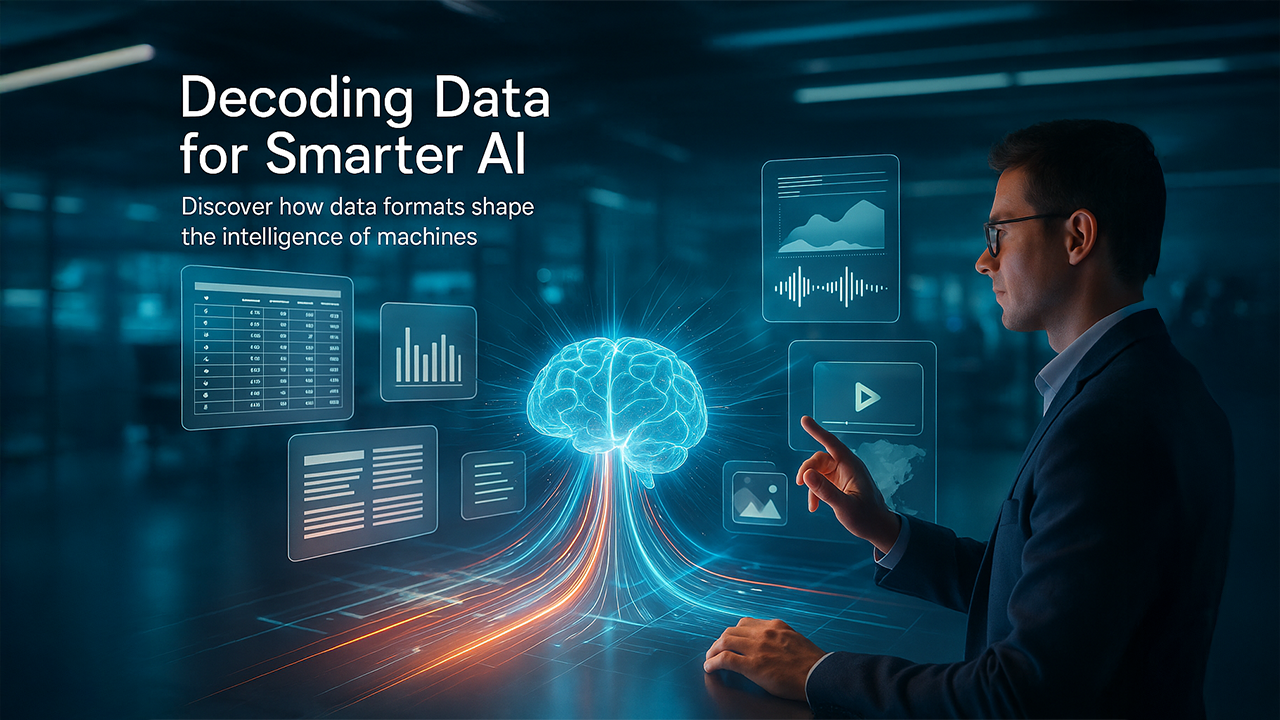More than having data, the format it is in can make a greater difference on how effectively the artificial intelligence system works. Without quality data, even the most advanced AI models can fail and can’t deliver relevant, meaningful results. This is why understanding types of data in AI is crucial for individuals working with machine learning, neural networks, or AI-powered applications.
Whether you’re managing a well-organized database or heterogenous multimedia content, every data format requires specialized processing strategy. From pattern detection and automation to machine learning, almost all features of AI depend on how well the data is formatted and prepared. These different datatypes empower AI systems to deliver high accuracy, enhanced performance, and robust real-world suitability.
This blog explains different types of data in AI, why they matter for successful deployment, and how to choose the right datatype for your AI system. A smart decision can make or break processing speed, storage capacity, modeling, and lastly model preciseness and performance.
What are the types of Data in AI?
The data types used in artificial intelligence systems are typically classified into three primary categories based on their structure, format, and behavior. These categories involve structured data, unstructured data, and semi-structured data at their fundamental level. Each type has its own features and capabilities that transform how AI algorithms identify and process insights from them.
In AI, structured data uses a fixed, predefined format with efficient management, such as rows and columns in a database. This streamlines processing, advances analysis, and keeps data retrieval smooth for both machines and humans.
Unstructured data doesn’t follow a fixed or predefined format and static data model, making it difficult for traditional systems to process and analyze data. The data contains several formats, like images, videos, audios, and text files, and requires advanced technology to generate insights.
Meanwhile, semi-structured data is referred to as a middle ground between these data types, offering organizational elements without tight table structures.
Beyond these specific classifications, there are more data modalities used by AI systems. This involves numerical data, time-series data, categorical data, image data, text data, audio data, and video data. These specific types of data in AI systems are segmented based on problem-solving abilities and the employed algorithms.
Key Data Types in AI
Structural Data
Structured data are organized in the most clear and straightforward format, typically arranged in tables with rows and columns. Each data presented in the table follows a consistent schema which makes it easily predictable. Financial records, customer databases, sales inventories, and sensor readings are the most appropriate examples of structured data.
Key Features of Structured Data
- The data follows consistent formatting across all records.
- All data is organized in tabular format with pre-defined fields.
- Highly searchable through structured query language (SQL) commands.
- Effectively suitable for relational database management system (RDMS).
- Store measurable information that machines can seamlessly process.
Semi-Structured
Semi-structured data fills the gap between the independent unstructured data and inflexible structured data. This data is not directly suitable for relational tables but uses markers and tags that represent a few levels of organization. Common structured data includes NoSQL, JSON, XML documents, and log files with integrated tags. The key benefit of these formats is their easy integration with multiple sources, and the challenge includes inconsistency and complex queries.
Core Characteristics Include
- Offers versatile schema depending on formats.
- Seamless integration of data from various composite systems.
- The structure of data may vary but still contains recognizable elements.
- More flexible and less consistent compared to structured data.
Unstructured Data
Unstructured data contains approximately 80-90% of all information generated on the respective day. This type of data for AI systems mainly involves information that isn’t organized in a proper, standardized format or fits into predefined fields. Compared to structured data, this counterpart follows diverse formats, like image, video, and audio, without inherent organization.
Key Features involved:
- No adherence to predefined format, structure, or data modality.
- Robust multimedia support, like images, videos, and text documents.
- Exceed the capability of structured data containing contextual information.
Specialized Data Types in AI
Textual Data
Text data has become the robust data type to power AI systems, especially communication and language processing systems. This includes social media posts, client feedback, legal documents, and research papers. It is mainly used by NLP models to identify patterns, streamline translation, analyse sentiments, and provide content suggestions. However, its lack of context, slang, cultural distinctions, and meaning variations makes processing text data intuitive and straightforward.
Applications of Textual Data
- Advanced chatbot training
- Content recommendation system
- AI-driven translation services
- Sentiment detection tools
Multimedia Data
Multimedia data typically contains both visual and auditory information that the AI system generated through neural networks. Image-based data includes satellite images, medical scans, and photographs, which are used for facial recognition and object identification. Audio data involves music, audio speech, and environmental sounds for audio segmentation and voice assistance systems. Meanwhile, video data covers contextual information, rich temporal dimensions, and spatial data for pattern recognition and action analysis.
Applications of Multi-media Data
- Autonomous vehicles (Object detection and Traffic indicator)
- Medical Diagnostics (Telemedicine and Imaging Analysis)
- Education (E-learning Platforms and Virtual labs)
- Gaming & Entertainment (VR, AR, and Live Streaming)
- Retail and E-commerce (virtual try-ons and product demos)
Graph/Network Data
Graph data shows connection and relation between objects via nodes and edges, making it crucial for knowledge graphs, social networks, and recommendation systems. This models information as a graph, where nodes represent entities and edges encode relationships, transforming how elements interact with each other. This data is used to identify irregularities, assume missing links, and detect communities.
Applications of Graph/Network Data
- Friend recommendation on social media platforms
- Precise product suggestions on e-commerce site
- Fraud detection in financial systems
Spatial/Geospatial Data
Geospatial data contains location-based information, like GPS coordinates, elevation maps, satellite imagery, and region-based data systems. AI-powered systems leverage this data for disaster response, traffic forecasting, precision farming, and climate change modeling. From autonomous vehicles to detect roads, agriculture systems to improve crop yields, and disaster response to coordinate relief efforts, spatial data used everywhere.
Key Applications
- Real-time traffic prediction
- Region-based service recommendation
- Climate change and urban planning
- Environment monitoring
Time-Series Data
Time-series data is all about how things shift over time. From logistics price and weather detection to real-time readings of IoT sensors, this data involves recording observations at continuous intervals. These insights are crucial for making predictions, identifying patterns, and real-time data analysis. AI-driven platforms, especially recurrent neural networks, use this data to track temporal patterns for predictive maintenance, failure detection, and demand forecasting.
Applications of Time-Series Data
- Stock market analysis and risk management
- Weather prediction and climate modeling
- Real-time patient monitoring and diagnostics
- Customer behavior and purchase patterns analysis
Why Different Types of Data in AI Essential
Each data type is unique and requires distinct processing strategies, algorithmic approaches, and storage solutions. A slight discrepancy can hinder performance and waste resources.
For every data type, a specialized architecture is used, like a graph neural network for relational data, RNNs for sequences, and CNNs for images. They require unique preprocessing techniques, from tokenization for text data to normalization for structured data. Also, storage requirements can depend significantly; for example, multimedia files require vast capacity as compared to structured databases. However, choosing the right data type in AI systems is essential to ensure finding and resolving key challenges of businesses effectively.
Conclusion
Understanding data types in AI forms the foundation for building effective systems. From structured databases to unstructured multimedia, each type brings unique characteristics that influence model performance. Success isn't about having more data—it's about having the right data in the right format, managed properly. The effort invested in understanding and managing your AI data pays dividends through improved accuracy, efficiency, and competitive advantage.



